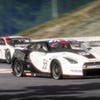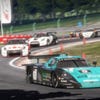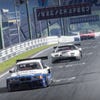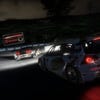Shift 2: Unleashed
"Our opposite is Gran Turismo."
Once every 18 months or so, fate dictates that I get to sit down in a small room at EA's Guildford headquarters to talk about the latest Need for Speed game with producer Jesse Abney. He's friendly, quick-witted and throws around phrases like, "At heart, we're a phototropic species, right?" so I tend to enjoy these meetings.
As a jet-setting videogame developer, of course, I'm willing to accept his calendar probably has greater highlights. This year, however, he certainly seemed to be having a pretty good time, and with good reason: Shift 2: Unleashed may be ditching the Need for Speed tag, but it's looking like a title the nebulous franchise can really be proud of.
Last time I saw the game, I was shocked and a little bit awed by the new helmet cam. The first Shift used its cockpit view and some nice depth of field effects to offer an unexpectedly visceral jolt to the often cold world of simulation driving. The follow-up really shakes you around until your teeth rattle, shoving you right into the driver's point of view, pushing you high up in your seat and turning every corner into a full on grand mal seizure.
It's part of what the developers call the driver's battle and – along with the game's new multi-discipline structure – it was inspired by some of the real world racers who consult on the games, according to Abney.
"Last year, after Shift, we announced a motor sport project. It followed drivers in a handful of racing disciplines," he explains, ticking them off on his fingers.
"Let's see: we had two in Formula Drift, and one team in GT3 that competed here. They were also an endurance team, so that's three disciplines. Then we had a time attack driver, so that's four disciplines, and some special vehicle builds covering drag and standing mile, so let's call that six disciplines.
"We had this direct connection to people who live that lifestyle in each of those kinds of events – these are people who drive these cars every day. Given that, and given that we had that understanding of their vehicles, their construct, and their lifestyles, we could translate that directly back into our career structure.
"That's the heart of the game," says Abney. "It's about getting into the helmet, through the eyes of the driver, and getting into that battle. That became the story of our career mode."
And that career mode turns out to be surprisingly inventive, with Shift 2's races divided up by different events – expect the likes of GT3, Endurance, Works, and Time-Attack, leading up to the GT1 end-game. Each of these is capped with a "boss" race, in which you take on a famous real world driver to win their car.
"I mean, when we say "boss" in a videogame, it's always that guy at the very end of the chain who has that thing you want," Abney explains. "In this case, it's the guy who has the car you want: the pinnacle of the rewards.
"The drivers who consulted for us, they've become the representatives of these different driving disciplines within the game. Beat them, and you'll get that great drift car, or that great GT3 Z4. They tutor you in each event, talk to you through the campaign in FMV sections, and then at the end you get to race them."
If that sounds like an unusually colourful structure for a simulation game, Abney's not sure the classification is really accurate anymore anyway. It certainly doesn't feel that much like a sim as the experience points rack up with each corner and cars collide in showers of sparks.

















